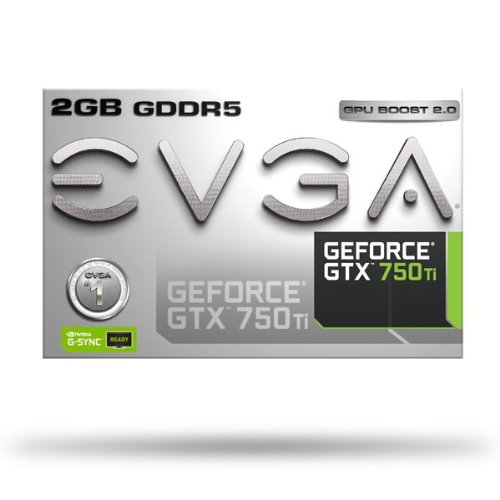UAE Shops - Established in 2002
عربى
Evga Geforce Gtx 750 Ti 2gb Ddr5
PRODUCT HIGHLIGHTS 1020 MHz Core – Boostable to 1085 MHz 640 CUDA Cores Maxwell Architecture 2GB GDDR5 vRAM 5400 MHz Effective Memory Clock 128-Bit Memory Interface DVI, DisplayPort, and HDMI Outputs 4K Resolution Support Active Fansink Cooler PCI Express 3.0 x16 Interfac Product Description EVGA GeForce GTX 750 Ti 2gb ddr5 The GeForce GTX 750 Ti Graphics Card from EVGA has been designed for gamers and enthusiasts after the additional processing power a dedicated GPU can provide. Not only can the card help video game graphics render smoother motion with more detail, it can also provide compute assistance to a growing number of GPU-aware applications. Through APIs such as OpenCL and CUDA much of the workload created by computationally heavy activities, such as transcoding video, can be shifted to the GPU freeing CPU resources and in many cases performing operations faster than the CPU alone is capable of. This version of the GTX 750 features a 1020 MHz GPU that can be boosted (overclocked) up to 1085 MHz. The GPU incorporates 640 CUDA Cores (stream processors) which not only act as general-purpose shaders for rendering display graphics, they also allow applications that support parallel programming to perform hundreds of simple computations at once. To move data to and from the GPU as efficiently as possible, it features 2GB of 1350 MHz GDDR5 RAM over a 128-bit memory interface. Because GDDR5 RAM moves data at four words per cycle, the effective memory clock speed is 5400 MHz, yielding a memory bandwidth of up to 86.4 GB/s. The card can be connected to a variety of displays from computer monitors to HDTVs to projectors, even to many 3D devices. It features a DVI-I port which support digital as well as VGA displays, an HDMI port, and a DisplayPort. Through the HDMI or DisplayPort outputs it can drive displays with resolutions up to DCI 4K (4096 x 2160). DirectX 11 Launched in 2009, DirectX 11 opened up more advanced possibilities for improved NVIDIA graphic rendering techniques through advanced tessellation. Some of these techniques include: NVIDIA HairWorks – Allows for many thousands of individual hairs to be rendered and animated as opposed to earlier implementations of polygon strips and transparent textures. NVIDIA FaceWorks – Uses the additional tessellated detail provided by DirectX 11 to render faces with a more realistically round shape, with improved lighting to show contours. HBAO+ Ambient Occlusion – Adds more realistic shading and shadowing where two surfaces or objects meet. DirectX 11 allows for higher quality AO without creating a large performance hit. NVIDIA Percentage Closer Soft Shadows – Creates more realistic shadows by progressively blurring them relative to the distance of the object from the surface where the shadow is cast. The softening of the shadows also reduces aliasing which can be distracting. NVIDIA Crepuscular Rays – Also known as light rays, light shafts, or god rays, DirectX 11 renders these rays with tessellation rather than intensive ray-marching or viewspace slicing. This results in realistic imagery which has less impact on performance and graphics memory while simultaneously reducing aliasing. NVIDIA Depth of Field – Also known as NVDOF, increases precision and quality in cinematic depth-of-field effects by allowing the separation of the subject from the foreground and background. Highlights in the background can take on a polygonal character, similar to as if they had been captured with a real camera. CUDA NVIDIA’s parallel computing platform which enables an increase in computing performance by harnessing the parallel nature of GPU processing. CUDA compatible applications can assign intensive parallel computing tasks, such as real-time video rendering, to the GPU to process, freeing up the computer’s CPU to run other tasks. 3D Vision Support When used with a 3D Vision compatible monitor and 3D Vision active-shutter glasses, full-HD resolution images are delivered to each eye. Additionally, with a 3D LightBoost compatible screen, image brightness will be maintained while using the glasses and ghosting will be reduced. PhysX NVIDIA’s hardware accelerated physics engine computes how objects move in space in real time. Having a physics engine precludes the need for programs to pre-animate rendered objects which can give an unrealistic “canned animation” feel. The PhysX engine also allows for designers to create more detailed objects, relying on the GPU’s processing power rather than a bloated programming back end. TXAA Temporal Anti-Aliasing is designed specifically to reduce temporal aliasing (crawling and flickering seen in motion when playing games). This technology is a mix of a temporal filter, hardware anti-aliasing, and custom computer generated film-style anti-aliasing resolves. Adaptive V-Sync NVIDIA’s Adaptive Vertical Sync minimizes stuttering and tearing by monitoring and adjusting the card’s frame rate output. At high frame rates, Adaptive V-Sync is enabled to slow down the output frame rate to prevent tearing as a result of losing sync with your monitor. At lower frame rates, Adaptive V-Sync will automatically be disabled to minimize stuttering. GPU Boost 2.0 Boosts the card’s clock speed in real time based on the target temperature. If the card is running below the set target temperature, GPU Boost 2.0 will increase the clock speed to improve performance. The target temperature can be reset depending on your preference, so you can have the card run more quietly for everyday tasks and older games, and run at full tilt during intense high-resolution gaming sequences. G-Sync Support When used with a monitor that has G-Sync hardware installed, the monitor’s refresh rate will sync and lock with the graphics card’s output frame rate. Establishing this sync removes tearing and stuttering which can result from conventional fixed screen refresh rates, especially important for gaming in stereoscopic 3D. An additional benefit of G-Sync is reduced lag so gamers will benefit from the improved command response time as well. GameStream Play your PC games from your computer using a compatible wireless device with minimal latency over-the-air. 4K Display graphics, games, and video in UHD resolution (3840 x 2160) for increased detail on 4K resolution displays. Games which support 4K resolutions will display greater detail for enhanced realism and reduced artifacts. 4K video from services such as Netflix and YouTube can deliver full resolution video for an enhanced media experience. Surround With a single card, you can expand your PC games across three displays in stereoscopic 3D for an “inside the game” experience. Add in a fourth accessory display to get access to your email, web, and other applications. DSR NVIDIA’s Dynamic Super Resolution is a scaling utility introduced with their Maxwell architecture. DSR uses the GPU architecture in order to take advantage of 4K capabilities with lower screen resolutions by having the graphics card render at 4K and then intelligently down-sample the output to fit the smaller screen. Aliasing and jagged artifacts are reduced by having a high-quality filter applied before the image is scaled down. SPECIFICATION GPU NVIDIA GeForce GTX 750 Ti: CUDA Cores: 640 Base Clock: 1020 MHz Boost Clock: 1085 MHz Memory Clock Speed: 5400 MHz Configuration: 2 GB Inteface: GDDR5 Interface Width: 128-bit Bandwidth: 86.4 GB/s Technologies Microsoft DirectX: 11.2 OpenGL: 4.4 CUDA: Yes Bus Support: PCI Express 3.0 x16 Display Support Display Connectors: 1 x DVI-I DL 1 x DisplayPort 1 x HDMI Maximum Digital Resolution: 4096 x 2160 Maximum VGA Resolution: 2048 x 1536 Multi Monitor Support: Up to 3 Power Requirements Power Consumption: 60 W Minimum System Power Requirement: 300 W PCI Power Connectors: N/A Dimensions Height: 4.4″ / 112 mm Length: 6.7″ / 170 mm Width: Dual-Slot



